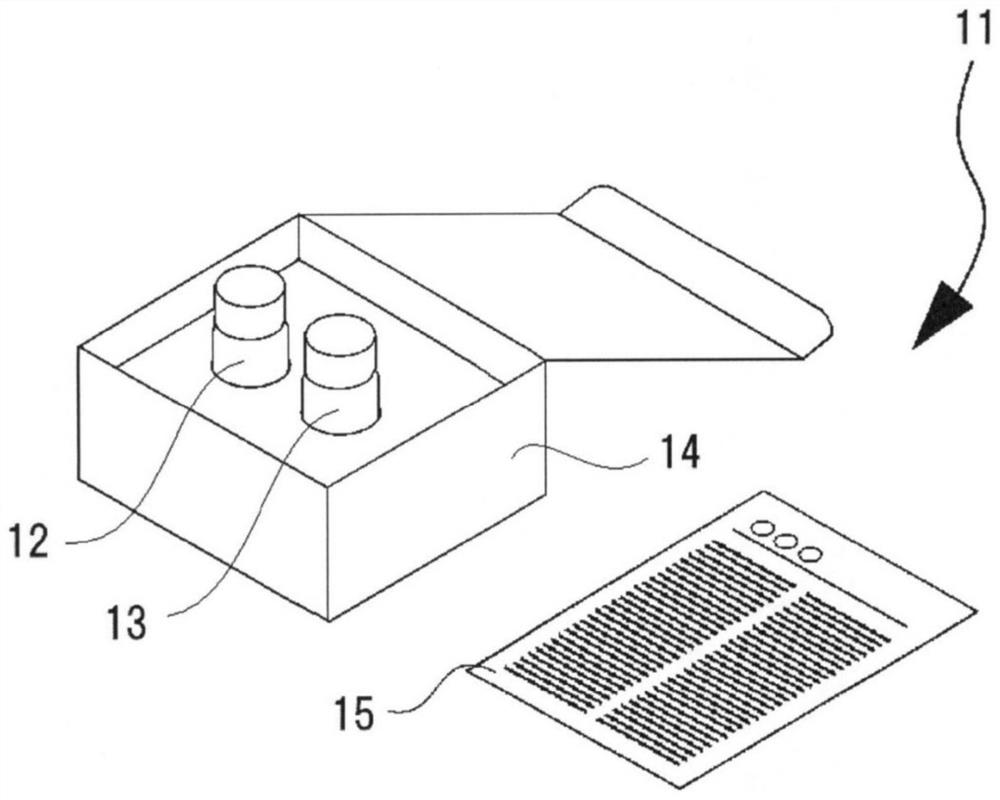Method for acquiring information on condition of patient with interstitial pneumonia and use thereof
A related information and interstitial technology, applied in the field of obtaining information about the condition of patients with interstitial pneumonia, can solve the problem of difficult identification of CTD-ILD and IIPs
- Summary
- Abstract
- Description
- Claims
- Application Information
AI Technical Summary
Problems solved by technology
Method used
Image
Examples
Embodiment 1
[0133] (1) Biological samples
[0134] As the biological sample, the serum of 102 patients with interstitial pneumonia was used. Among 102 patients, 16 were diagnosed with CTD-ILD (CTD-ILD group), 35 were diagnosed with IPAF (IPAF group), and 51 were diagnosed with IPF (IPF group) .
[0135] (2) Determination of biomarkers
[0136] (2.1) Determination of CXCL9
[0137] The following R1 to R5 reagents were used to measure the concentration of CXCL9 in the serum of each patient using a fully automatic immunoassay device HISCL-5000 or HISCL-2000i (Sysmex Corporation).
[0138] ·R1 reagent
[0139] The anti-MIG monoclonal antibody (RANDOX) was digested with pepsin or IdeS protease by conventional methods to obtain Fab fragments. The Fab fragments are labeled with biotin in a conventional method, and dissolved in a buffer containing 1% bovine serum albumin (BSA) and 0.5% casein to obtain R1 reagent.
[0140] ·R2 reagent
[0141] The magnetic particles with streptavidin immobilized on the sur...
Embodiment 2
[0152] (1) Identification of CTD-ILD and IPAF
[0153] By ROC analysis, for the CXCL9 concentration and CXCL10 concentration in the serum, the optimal cut-off value for distinguishing the CTD-ILD group (16 persons) and the IPAF group (35 persons) of Example 1 was determined. Calculate the sensitivity, specificity and area under the curve (AUC) of the judgment using the set cutoff value. In this determination, when the concentration of CXCL9 or CXCL10 is the same as or higher than the cut-off value, the patient is determined to be CTD-ILD. In addition, when the concentration of CXCL9 or CXCL10 is lower than the cut-off value, it is determined that the patient is not CTD-ILD. The ROC curve obtained is shown in Figure 7 and 8 . Table 1 shows the cut-off value (pg / mL), sensitivity (%), specificity (%) and AUC of each biomarker.
[0154] 【Table 1】
[0155] Biomarkers Cutoff Sensitivity (%) Specificity (%) AUC CXCL932.587490.72 CXCL10287.160800.75
[0156] According to Table 1, ...
Embodiment 3
[0164] (1) Biological samples
[0165] As the biological sample, the serum of the patient with interstitial pneumonia of Example 1 was used.
[0166] (2) Determination of biomarkers
[0167] (2.1) Determination of CXCL9 and CXCL10
[0168] As the CXCL9 and CXCL10 concentration values in the serum of each patient, the measured values obtained in Example 1 were used.
[0169] (2.2) Determination of KL-6
[0170] The concentration of KL-6 in the serum of each patient was measured using HISCL KL-6 reagent (Sekisui Medical Co., Ltd.) and ISCL-5000 or HISCL-2000i (Cysemex Corporation). The measurement procedure of KL-6 is the same as the measurement of CXCL9 in Example 1. The HISCL KL-6 reagent includes R1 reagent containing biotin-labeled mouse anti-KL-6 monoclonal antibody, R2 reagent containing STA-bound magnetic particles, and R3 reagent containing ALP-labeled mouse anti-KL-6 monoclonal antibody. The HISCL R4 reagent of the measurement buffer, the HISCL R5 reagent containing CDP-Sta...
PUM
| Property | Measurement | Unit |
|---|---|---|
| particle size | aaaaa | aaaaa |
Abstract
Description
Claims
Application Information
 Login to View More
Login to View More - R&D
- Intellectual Property
- Life Sciences
- Materials
- Tech Scout
- Unparalleled Data Quality
- Higher Quality Content
- 60% Fewer Hallucinations
Browse by: Latest US Patents, China's latest patents, Technical Efficacy Thesaurus, Application Domain, Technology Topic, Popular Technical Reports.
© 2025 PatSnap. All rights reserved.Legal|Privacy policy|Modern Slavery Act Transparency Statement|Sitemap|About US| Contact US: help@patsnap.com



